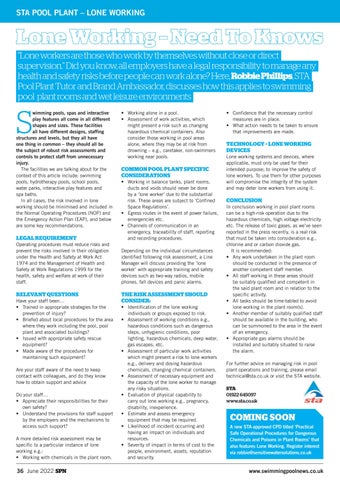STA POOL PLANT – LONE WORKING
Lone Working – Need To Knows “Lone workers are those who work by themselves without close or direct supervision.” Did you know, all employers have a legal responsibility to manage any health and safety risks before people can work alone? Here, Robbie Phillips, STA Pool Plant Tutor and Brand Ambassador, discusses how this applies to swimming pool plant rooms and wet leisure environments
S
wimming pools, spas and interactive play features all come in all different shapes and sizes. These facilities all have different designs, staffing structures and levels, but they all have one thing in common – they should all be the subject of robust risk assessments and controls to protect staff from unnecessary injury. The facilities we are talking about for the context of this article include: swimming pools, hydrotherapy pools, school pools, water parks, interactive play features and spa baths. In all cases, the risk involved in lone working should be minimised and included in the Normal Operating Procedures (NOP) and the Emergency Action Plan (EAP), and below are some key recommendations.
• Working alone in a pool. • Assessment of work activities, which might present a risk such as changing hazardous chemical containers. Also consider those working in pool areas alone, where they may be at risk from drowning – e.g., caretaker, non-swimmers working near pools.
COMMON POOL PLANT SPECIFIC CONSIDERATIONS
LEGAL REQUIREMENT
• Working in balance tanks, plant rooms, ducts and voids should never be done by a ‘lone worker’ due to the substantial risk. These areas are subject to ‘Confined Space Regulations’. • Egress routes in the event of power failure, emergencies etc. • Channels of communication in an emergency, traceability of staff, reporting and recording procedures.
Operating procedures must reduce risks and prevent the risks involved in their obligation under the Health and Safety at Work Act 1974 and the Management of Health and Safety at Work Regulations 1999 for the health, safety and welfare at work of their staff.
Depending on the individual circumstances identified following risk assessment, a Line Manager will discuss providing the ‘lone worker’ with appropriate training and safety devices such as two-way radios, mobile phones, fall devices and panic alarms.
RELEVANT QUESTIONS Have your staff been… • Trained in appropriate strategies for the prevention of injury? • Briefed about local procedures for the area where they work including the pool, pool plant and associated buildings? • Issued with appropriate safety rescue equipment? • Made aware of the procedures for maintaining such equipment? Are your staff aware of the need to keep contact with colleagues, and do they know how to obtain support and advice Do your staff… • Appreciate their responsibilities for their own safety? • Understand the provisions for staff support by the employers and the mechanisms to access such support? A more detailed risk assessment may be specific to a particular instance of lone working e.g.: • Working with chemicals in the plant room.
36 June 2022 SPN 36_SPN_June_2022_STA.indd 36
THE RISK ASSESSMENT SHOULD CONSIDER: • Identification of the lone working individuals or groups exposed to risk. • Assessment of working conditions e.g., hazardous conditions such as dangerous steps, unhygienic conditions, poor lighting, hazardous chemicals, deep water, gas escapes, etc. • Assessment of particular work activities which might present a risk to lone workers e.g., delivery and dosing hazardous chemicals, changing chemical containers. • Assessment of necessary equipment and the capacity of the lone worker to manage any risky situations. • Evaluation of physical capability to carry out lone working e.g., pregnancy, disability, inexperience. • Estimate and assess emergency equipment that may be required. • Likelihood of incident occurring and having an impact on individuals and resources. • Severity of impact in terms of cost to the people, environment, assets, reputation and security.
• Confidence that the necessary control measures are in place. • What action needs to be taken to ensure that improvements are made.
TECHNOLOGY – LONE WORKING DEVICES Lone working systems and devices, where applicable, must only be used for their intended purpose; to improve the safety of lone workers. To use them for other purposes will compromise the integrity of the system and may deter lone workers from using it.
CONCLUSION In conclusion working in pool plant rooms can be a high-risk operation due to the hazardous chemicals, high voltage electricity etc. The release of toxic gases, as we’ve seen reported in the press recently, is a real risk that must be taken into consideration e.g., chlorine and or carbon dioxide gas. It is recommended: • Any work undertaken in the plant room should be conducted in the presence of another competent staff member. • All staff working in these areas should be suitably qualified and competent in the said plant room and in relation to the specific activity. • All tasks should be time-tabled to avoid lone working in the plant room(s). • Another member of suitably qualified staff should be available in the building, who can be summoned to the area in the event of an emergency. • Appropriate gas alarms should be installed and suitably situated to raise the alarm. For further advice on managing risk in pool plant operations and training, please email technical@sta.co.uk or visit the STA website. STA 01922 645097 www.sta.co.uk
COMING SOON A new STA-approved CPD titled ‘Practical Safe Operational Procedures for Dangerous Chemicals and Poisons in Plant Rooms’ that also features Lone Working. Register interest via robbie@sensitivewatersolutions.co.uk
www.swimmingpoolnews.co.uk 12/06/2022 22:41
